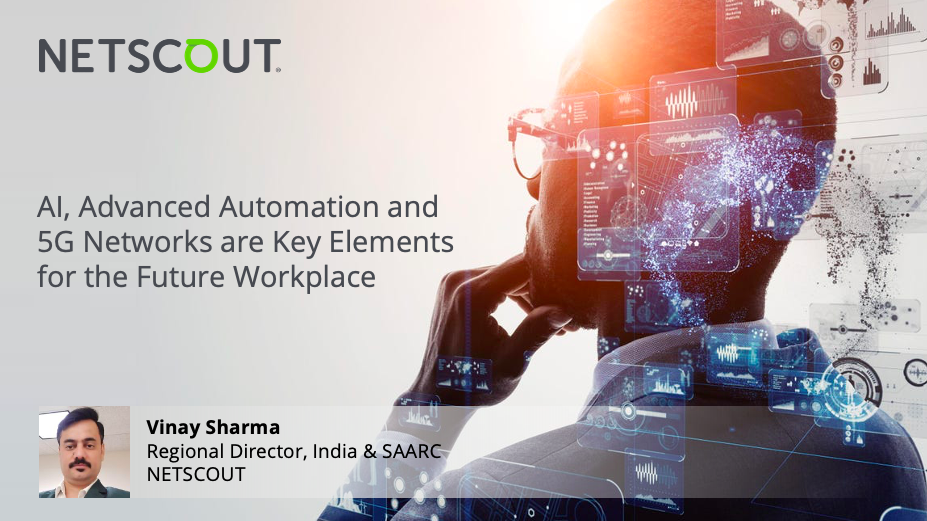AI, Advanced Automation and 5G networks are key elements for the future workplace - Vinay Sharma, Regional Director, India & SAARC, NETSCOUT

The rollout of 5G network, which is all set for next year in our country is expected to leverage new radio technology and a very different network architecture. There will be delivery of higher bandwidth and lower latency than 4G and 3G of today, requiring computing resources to be closer to mobile devices. The complexities of this fifth-generation mobile networks call for a very high service level, which is made possible by Artificial Intelligence (AI) technologies without relying completely on human resources. 5G is about 100 times faster than 4G and is set to provide unprecedented opportunities for businesses and helps in creating a safer and more sustainable future. AI can be leveraged for network diagnostics, personalised apps or cybersecurity.
Organisations across industry verticals are set to be transforming dramatically by enhancing efficiency, productivity and customer experience by deploying AI technologies. Connected devices, billions of them will exchange information in real time, enabling innovative solutions for the benefit of the businesses, individuals and the society in general.
Enhanced customer experience
AI undoubtedly will provide the robust foundation to 5G mobile networks. Huge amounts of data on these networks can leverage AI for unique customer experience where the latter’s expectations are evolving very fast. AI technologies will strengthen the capabilities of 5G networks by analysing and examining data to support distinctive user experience for business critical and mission critical use cases. For better use of 5G network, mobile operators have to provide service level guarantee for an application or class of devices, while leveraging analytics to add newer revenue generating services.
End-to-end visibility
Round-the-clock visibility and reporting are required to assure and validate delivery to the customer. This is where NETSCOUT’s solution plays a key role. For 5G deployments, NETSCOUT’s carrier-grade monitoring designed for the cloud, provides end-to-end visibility for any cloud, network and workload. This also includes cloud, virtual RAN (Radio Access Network), virtual core and edge computing throughout the 5G lifecycle. Visibility into real-time performance of applications and user experience is gained while validating that micro-segmentation security controls are correctly implemented.
Advanced Automation capabilities
AI’s advanced automation strengths make 5G networks scalable for the future workplace. All mundane and routine tasks can be handled by AI, freeing manpower to focus on higher order intellectually stimulating tasks. Greater workplace efficiency is achieved with repeated workflows getting automated and co-ordination with remote teams will become smoother with AI too. It is important to note that 5G environment is complex, diverse and multi-dimensional. Only by integrating AI into the network, the complexities can be navigated with greater accuracy and efficiency. Being predictive and proactive the 5G networks deliver the advantage of feasibility.
Cybersecurity enabled
With the attack surface massively expanding, it is impossible to depend only on human intelligence to improve the cybersecurity posture. AI and Machine Learning (ML) technologies are very essential for quickly analyzing huge number of data sets by pattern recognition and detecting threats. These technologies learn from past experiences and continuously improve to enable addressing future attacks too. Automated threats such as bad bots can be detected with AI and ML. Access controls and processes can be improved with cyber resilience reinforced, in addition to the delivery of end-point protection, with AI. When AI is employed, it automatically discovers all possible interferences with the applications that are dependent on 5G networks.
However, the AI implementation process could be challenging given the diverse nature of the 5G ecosystem. It is therefore crucial to have end-to-end visibility into all relevant segments, from service types to contrasting cloud classifications. Furthermore, the 5G experience is much better when both human and machine intelligences are combined. Yes, 5G uniqueness is very much enhanced when powered by AI that is crucial to future workplaces.



